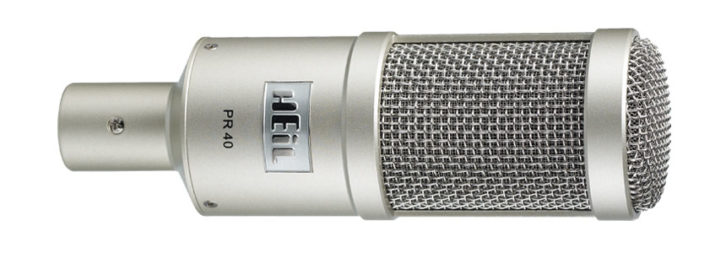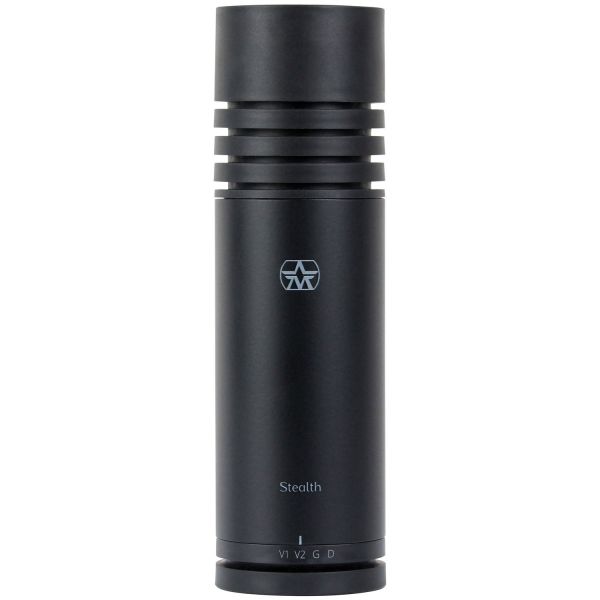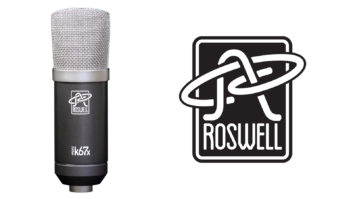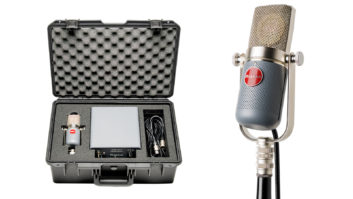

So you’ve purchased your first audio interface, got some recording software, splurged on a pair of pro headphones (hopefully some near field monitors, too) and you’re driving your first DAW (digital audio workstation). You’re finding that good results are pretty easy to get, that this is seriously fun stuff and are wondering where to go next with this whole audio production thing. Allow me to suggest one thing: Get some microphones.
It’s easy advice to give, as mics are the window to worlds of audio understanding, enabling the most impactful ability and choice in audio production, using mic technique and selection to capture sound of all varieties in the most accurate, or at least the most useful, way possible.
Every studio microphone is the “ears” of your audio recording kit and no single model will ever do, no matter how perfect or expensive it is. As you’ll soon see, audio capture isn’t so much about mics that pickup sound waves perfectly; rather, it’s about microphones that pickup sound waves in a manner that your ears “want” to hear and about the microphone technique required to create euphony—the ability to recreate sounds better than how they are heard in real life, in ways that will delight and astound listeners of all varieties.
The cold, hard—but exciting—truth is, you’ll need at least five different kinds of studio microphone to be able to utilize proper mic techniques, have flexibility and be able to pursue artistic choices in your endeavors.
Let’s dive into the different mic categories and look at what applications and techniques are typical, what classic microphones we would have used in the past and what modern-day mic options may offer a twist on such time-proven and tested formulas.
Here’s the studio microphone categories we’ll explore (click the links to jump ahead): Dynamic Mics • Large Diaphragm Condenser Mics • Small Diaphragm Condenser Mics • Ribbon Mics • Low Frequency Enhanced Dynamic Mics
Dynamic Mics

For many fledgling engineers, their first studio microphone is a dynamic mic, as much for the low cost as anything else. Totally adequate dynamics start out in the “less than $100” range; they’re simple to use, rugged, consistent and aren’t that sensitive to loud sounds, so it’s hard to “blow them up” and force them to distort. Many people start out with a dynamic handheld mic—the one with a long handle and a ball-shaped windscreen/pop-filter that helps to reduce those dreaded popping “P” plosives that blow-out PA systems, distort speakers—and which are the delight of hip-hop beatboxers everywhere.

Another nice thing about dynamic mics is their taming of sibilance, or the “S” sounds that are part of S’s and C’s. They’re important sounds that have to be heard in order for you to understand speech, but for certain people (and certain instruments), these sounds can get unruly and downright nasty when picked up by a mic. Dynamic mics typically have an appropriate amount of sibilance; in fact, they are often considered a little dark and need a slight treble boost to perform ideally with intelligibility, detail and clarity.
Your typical dynamic mic has a cardioid or hyper-cardioid pickup pattern—that is, the mic is sensitive directly in front of it, not very sensitive on the sides at all and rejects sound coming from the rear rather well (a hyper-cardioid pattern is like a cardioid, but even narrower on the sides, with a just a touch of unwanted sensitivity at the rear, oddly enough). You’ll sometimes see dynamics with an omnidirectional pattern (sensitive equally in all directions), but these aren’t very common, even if they are occasionally useful.
How To Use Them

Technique-wise, dynamics are quite good at the modern technique of miking a source from a very short distance and getting a touch of proximity effect (or bass boost)—“close miking” as it’s obviously called. This technique rejects room sound by bombarding the mic with up-close volume, so that it sounds very “in your face”—even more aggressive than the reality of listening from a close distance—and conveys lots of power with thickness from bass and low-mids. Dynamics can easily handle the high volumes of such placement, convey those low frequencies with power and substance, and reject unwanted off-axis sound pretty well, too (sounds like cymbals, guitar amps and degrading sound reflections off of the walls).

Dynamics excel on any job with excessive volume like drum kits, percussion, guitar amps, sound effects, horns and loud vocals. Their ruggedness allows them to perform even in temperature, humidity and vibration extremes, so they’re great for difficult tasks like news gathering, harsh environments and “zero-failure tolerance” gigs like press conferences.
Using a dynamic mic is easy; just aim it at your sound source, get in close if you want some extra punch and proximity effect, or back off if you want some “air” and room sound. You likely won’t have to worry about mic overload, so turn up your preamp’s gain, and EQ/compress to taste in the mix. Look to filter out low-end if you got in too close with proximity effect, dip out some boxy midrange around 300 – 400 Hz and possibly brighten up the top-end around 8 kHz if more detail is needed.
The Classic and Current Models
The classic mics here—the proverbial dynamic duo—are arguably the most popular mics of all-time: the Shure SM57 and SM58. They’re nearly identical in their performance, sounding only slightly different due to their different windscreens—the ball-ended SM58 is ideal for vocals, while the ultra-rugged, narrow-tipped SM57 is perfect for instruments. They’re mostly known for rugged success on-stage, but 57s see lots of studio work, too, especially with snare drums and guitar amps.
The Electro-Voice RE-20 is the essential mic that radio DJs have relied on for decades, and it has now become an essential mic for podcasters for all the same voice-massaging features. The updated RE320 brings a hotter output and optional mid-sculpting.
Perhaps the most desirable dynamic ever for instrument recording is Sennheiser’s MD421-U. These wedge-shaped, Sixties mod-looking mics (and their modern MD421-II counterparts) have brought thickness and warmth to countless trumpet, horn, guitar amp, bass amp and tom tom recordings.

Today, the dynamic mic scene is dominated by the ubiquitous Shure SM7B. What was once a mic for DJs and announcers has become the “mic du jour” for indie crooners, popsters, singer/songwriters and metal screamers, too. For blistering loud screamers and yellers, the SM7B smooths out shrillness and the built-in variable high-pass filters (HPFs) allow careful filtering out of unwanted chestiness.
Heil Sound’s PR40 (with a big 1” diaphragm and wide frequency response) and its handheld PR35 are both top studio performers that hold their own onstage, too. Also, British newcomer Aston brings a clever new wrinkle to choices in dynamics—its ultra-versatile Stealth offers not only four different tonal voicings but also the boost of active circuitry (with increased sensitivity and output) when 48 V phantom power is applied.
Large Diaphragm Condenser Mics

Your first mic might have been a large diaphragm condenser mic instead of a dynamic and they can be a much better choice for voice work, whether singing, talking or rapping. Compared to a dynamic mic, a large diaphragm condenser (LDC) offers a much more defined sound—one laden with more treble and detail, with hotter output from the mic requiring less gain at the preamp. It also has circuitry that requires external power, such as the 48-volt phantom power that is provided by the mic preamps in your interface.

In addition to their identifiable sonic properties, many LDCs are also larger and often side-address (they’re sensitive to sound on one side of the windscreen, not directly in front like a handheld) with multiple variables to sculpt the sound.
LDCs have a somewhat larger diaphragm than dynamics (and a capsule to house it and the backplate), and multi-pattern LDCs have two diaphragms and can therefore combine their outputs in various ways, creating useful polar patterns like directional cardioid, figure-8 dual-cardioid, omnidirectional and sometimes even hyper (or super) cardioid.
LDCs with multiple polar patterns, pads, filters and more are “fully featured”—you’ve got to own at least one of these versatile performers or you’re going to miss out on a lot of great possibilities.
How to Use Them

You can use LDCs for close miking, but be forewarned—the output will be excessively loud. You’ll need either a mic preamp with a pad to decrease sensitivity (often -20 dB) or a LDC with a built-in pad (sometimes -10 dB, sometimes -20 dB, sometimes both). Also, be warned that off-axis sound from other sources are picked up quite a bit by LDCs—more than with dynamics—and the sound is not pleasant; it’s often brittle and harsh.
But LDCs handle room, area and distance miking much better than dynamics do, picking up incredible detail, ample low-end and crisply defined high-end. Many people say that a pair of properly spaced LDCs in a stereo technique closely approximates human hearing and “being there.”

A pair of LDCs can be used to achieve a number of stereo techniques that can present a very wide, deep and interesting sound field; exactly which one to use for any given task is the stuff of artistry. You can go with X/Y for a strong center image and great mono compatibility; ORTF for more width and excitement but less mono accuracy; a spaced pair for extreme width with less center and less power; or M-S (Mid-Side) for a raw capture of center and side information that requires some complicated post-production manipulation after the fact but yields great imaging and superior flexibility.
LDCs are going to excel wherever detail and sensitivity are more important than volume handling or power—for instance, acoustic instruments of all shapes and sizes, vocals of all types, pianos, rooms and ambiences, and anywhere where the priority is a capture of full frequency response and a big life-like sound.

Usage can be complicated, but offers great flexibility if you employ the typical wealth of features. Use the pad if loud sources are causing distortion, even if only on occasional loud peaks. To tame muddiness, try the high-pass filter (HPF – only highs will pass, filtering out lows) and experiment with close-positioned proximity effect, with or without the HPF. Most importantly, experiment with polar patterns, as you’ll be delighted to find the sheer number of tonal options provided by omni, figure-8 and hyper-cardioid patterns.
The Classic and Current Models

There are two classics that have defined excellence in LDCs through the decades: the Neumann U87 and the AKG C414, both in numerous, slightly different iterations. The U87 is truly utilitarian, with three polar patterns, a pad and a HPF making it capable of most any instrument or voice job, even if it has become most iconic for vocal work. The 414 is even more versatile, with more patterns, pads and filters making it legendary as a sort of a Swiss Army knife of audio capture.
Many modern LDCs have taken all the things we love about their predecessors and added forward-thinking versatility. The Roswell Colares is a favorite for vocals with built-in saturation (mild- and warm-sounding distortion) that is more useful across a berth of styles than you’d ever imagine, and it’s defeatable too.

Austrian Audio’s OC818 has taken the capsule and concept of the C414 and added futuristic enhancements, like polar pattern, pad and HPF control from an app on your phone, as well as recording the output of each diaphragm separately and then selecting polar patterns in post-production. Lewitt offers its multi-pattern LCT 940, which has both tube and FET amplifiers within, as well as the ability to blend them in any proportion for fine-tuned versatility.
Fear not if you’re on a budget—there are numerous entry-level LDCs that perform adequately and affordably: Audio-Technica’s AT2050, Behringer’s C3 and Rode’s NT2-A are all more than capable for very little cost.
Alternately, a modern modeling mic (which uses software to emulate numerous classic LDCs) may be an ideal choice for your first LDC, especially if you’re still searching for that perfect match for your voice or tonal preferences. A modeled studio microphone can sound great, with believably authentic tones and they’re only getting better as advances in their software and preamp modeling further close the gap between the “real deal” and digitally imitated signal paths. The Slate Digital VMS and Townsend Labs Sphere L22 are good examples here, even if you might want to purchase the actual hardware after the models stimulate your tastes.
Small Diaphragm Condenser Mics

Having just a large diaphragm condenser mic isn’t going to be enough versatility for your kit—not with a world of small diaphragm condensers ready to spice things up. Like a painter with numerous brushes, you’ll find the “stroke” of a SDC has a unique focus, clarity and punch that LDCs (or dynamic mics, for that matter) just cannot provide. Though detailed like a LDC, SDCs are even more exacting than many LDCs, and when used in pairs, provide some of the most accurate reproduction possible. Sure, SDCs can be a little self-noisier than LDCs, but their transient capture (that sharp leading-edge of a sound) is oh so accurate and lifelike, and their off-axis pickup is typically smoother than LDCs, too.
How to Use Them

Use this kind of studio microphone for acoustic instruments, drum overheads, orchestras, choirs, pianos, percussion arrays, natural ambiences…. The list of superb SDC apps goes on and on. Used up-close, the sound can be kind of rude or even overload the mic, but SDCs excel when pulled-back a bit at moderate and long distances. They’re generally really good at stereo techniques, too, and are often easier to position than a pair of bulky LDCs. Using SDCs is a lot like LDCs, except pads, filters and patterns aren’t typically offered (if your SDCs do actually have them, use them by all means).
SDCs often come with foam windscreens which are useful for not only outdoor applications and preventing plosives, but also for taming bright, high-end response in what can sometimes be rather thin, bright mics. Most of all, experiment using stereo patterns with your SDCs, where the realism and air greatly benefit drum overheads, pianos, vocal groups, acoustic guitars, strings and much of anything with width and dimension to it.
The Classic and Current Models

The classics in this studio microphone category are once again built by the Germans and Austrians. Neumann’s KM84 and subsequent KM184 are wonderfully focused and euphonic, with a high-end that is sparkling, crisp and to die for, while AKG’s C451 (cardioid, but often fitted with interchangeable omni or hyper-cardioid pattern capsules) is a utilitarian’s dream, with a life-like midrange reproduction and surprisingly impressive low-end. Shure’s SM81 is also a classic SDC favorite, especially for drum overheads.
Worthy of mention is a category of SDCs known for their stark accuracy, reference consistency, availability in omni configurations and high price—Elite SDCs if you will. DPA 4006s, Schoeps Colette series, Earthworks’ super time-coherent models and Bruel & Kajers’ (B&K) measurement microphones are standouts in this apex group, which you’ll find recording orchestras, jazz and in the hands of picky uber-producers.

Modern variants are plentiful at all price points and in my many years as an educator, I must say I’ve tried literally dozens of brands/models of SDC pairs and found them all to be adequate, if not exactly stellar. You’ll get less sizzly high-end and nastiness, and more smooth treble with less ear fatigue as you move up the price scale. I’m fond of the Vanguard Audio Labs V1S stereo kit with its interchangeable cardioid / hyper-cardioid / soft-cardioid / omni capsules (wide-cardioid is perfect for when you want to hear a little more of the room).
Today, there are pairs of SDCs with amazing price-to-performance ratios, notably Lauten Audio’s LA120 (with high- and low-pass filters) and Audio-Technica’s AT4041, which will outperform the lowest price models with a smoother high-end response and less self-noise.
Ribbon Mics

Now let’s do a 180 degree swing: What about those times when you want less precision and less excruciating detail? What about when things sound way too harsh for a dynamic mic, much less a condenser mic or two? The answer, of course, is the slow-moving, dull-sounding, bottom end-creating warmth of a ribbon mic. Whether a short or a long ribbon, most ribbon mics are figure-8 in their polar pattern, lean naturally towards accentuating low-mids, slightly dull their transients and smooth out their peaks, rejecting sound in the nulls of their “8” to an amazing degree while accepting EQ (especially of the high-end boosting variety) surprisingly well.
How To Use Them

Ribbons are quite sensitive, so you’d best not drop the mic, or blow into the ribbon or expose the mic to excessive SPL (sound pressure level), so close-miking isn’t possible on many drums or loud sources. That figure-8 pattern is often viewed as a liability, but I tend to disagree; it’s a useful feature. A ribbon mic for room ambience is great, as it picks up the source directly and the reflections coming in from the rear; just carefully position the mic’s distance from the source to get an ideal room balance, maybe even room reverb in larger spaces. Try placing the nearest sound source that you’re trying to reject with your ribbon mic right smack in the 90 degree (or 270 degree) off-axis position, and the polluting sound will seem to disappear from your ribbon’s track, especially if you can get your ribbon in fairly close to the sound you do want to pick up.

Don’t forget to try a ribbon where a smooth and silky top-end is needed. Try close miking a vocal for intimate detail and first carefully tune a HPF to filter-out just enough unwanted rumble without losing fullness. Find the spot where the mic is resonating in the mids (likely around 400 to 500 Hz) and notch out a few dB, put a high-frequency shelf at about 8 kHz and start boosting it until the vocal is sweetly detailed and crisp without sounding lispy, irritating or unnatural (you might have to boost a lot, maybe even a whopping +12 dB; just don’t add too much noise in the process).
The Classic and Current Models

Classic ribbons are still used today despite their fragility, ancient design and expensive cost; they simply sound gorgeous, huge and lush (words truly cannot describe). RCA 44s and 77s from the post-WWII era are the holy grail of ribbon mics, but slightly newer Coles 4038s (a long-standing favorite of the BBC and anglophile recordists) and Beyerdynamic M160s (that iconic drum intro to “When the Levee Breaks” by John Bonham of Led Zeppelin? Yep that’s the sound of 160s) carry the classic tone in to the modern era.

Today, we’ve got ribbon mics that are sturdier, handle more SPL and have more high-end response (at least on some models), like Royer’s guitar-cabinet favored R121. AEA—maker of vintage throwbacks and post-modern designs, too—offers up passive or active-electronics R84, and there’s also the sE Electronics RNR1 Rupert Neve-designed ribbon, which is perfection on guitar cabinets and vocals, surprisingly enough, with sweet high-end response.

Even on a budget, there’s worthy choices out there in this category of studio microphone, like the sE Electronics X1R, a solid performer. A favorite among my students is the MXL R144, which is voiced with prominent mids so it sounds warm yet defined on drum room and electric guitars. Cascade makes a line of ribbon variations at great prices, allowing a little experimentation if you get sucked down the whole ribbon mic rabbit-hole as so many people (rightfully) do.
Low Frequency Enhanced Dynamic Mics
Then there’s “bass mics” or “kick mics” or “large diaphragm dynamic mics” as they’re often mistakenly called (It’s not so much that they have bigger diaphragms as they do bigger bodies with resonant chambers and features to enhance low-frequency reproduction). They aren’t exactly versatile, but when low-frequencies are what you need, low-frequencies are what you get. These mics are dynamic and are always amply windscreen-protected so they can handle the brutal SPL of a kick drum no problem. In fact, foley and effects recordists will often use these mics to record jet take-offs, guns, explosions and engines without distortion.
How to Use Them

You’ll find uses for this category of studio microphone on kick drums, floor toms, bass guitar amps, tubas and anything that needs more “boom and butt” than “bite and crispness.” I’ve also put them under pianos to add some thickness, on baritone guitar amps and behind cajons (when paired with a condenser to grab the highs). Listen in solo if you dare, but don’t be surprised if the sound seems oddly unbalanced; check your track again without solo (or PFL) and note how your track actually blends into the mix naturally. Furthermore, getting the bottom-end just right usually takes some EQ and compression to notch out resonant frequencies of excessive bass response, careful EQ boosts to make up for any hollow holes in the response and the application of some compression to help smooth out, congeal and increase consistency.
The Classic and Current Models

Back in the day, AKG absolutely owned this category of studio microphone, starting with the D12, the world’s first bass-enhanced mic. It followed that widely successful mic with the ubiquitous D112, the green-rimmed egg that was found on countless stages and in countless studios through the 90s. Today, AKG carries on the tradition with the D12 VR (with three voicings and phantom power-activated active electronics). All the major players have worthy “kick drum mics” today, with the V Kick from sE Electronics being a favorite amongst touring players, while other top performers include Sennheiser’s E902, Heil’s PR48 and Avantone Pro’s Pro Kick (actually a small speaker wired in reverse to be a large bass drum mic).
The Ever-Evolving Studio Microphone Locker
Now that you’ve got all your bases covered (including your basses), don’t be surprised if you find yourself craving the specialized abilities of a more exotic studio microphone. Shotgun mics for tightly focused vocals, vintage mics for throwback tones, body-worn mics for unique perspectives, stereo mics for their wide perspective and easy placement, contact mics for direct pickup…. The list, and the adventures, go on and on!
Further Reading: How to Pick a Studio Microphone for Podcasting
Can a Neumann TLM 103 or AKG C 451 EB Mic Record an Entire Band?
Rob Tavaglione owns and operates Charlotte, NC’s Catalyst Recording and has been a longtime studio contributor. www.twitter.com/robtavaglione







